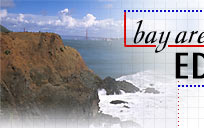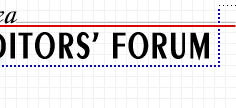
 |
|
||||||||
 |
Current Issues in Production
September 19, 2000
Organizers: Sara Shopkow, Rosana Francescato, Tedi Crawford
Notes By Jeanne Pimentel
Panelists Paul Butzler of Agilent Technologies, Joyce Giasso of Lucent Technologies, and Peter Fenczik of Macromedia discussed issues in production that editors should be aware of at the September BAEF meeting.
For the last five years, Butzler has worked at Hewlett-Packard (now Agilent Technologies) on the 600-page catalog of its Custom Measurement Group. He collects raw data and images from thirty divisions worldwide and organizes it for publication in English, with a Japanese version. When Hewlett-Packard spun off its Custom Measurement Group into Agilent Technologies a year ago, they started using Web technology to manage international print publication. Working out of Mouse House, a Web design and distribution agency, has proved to be an excellent marriage of the two technologies. Within a few months they initiated a new efficient process to handle input from 500 to 600 authors worldwide. The key was using PDF files that can be read by Adobe's Acrobat on any computer.
Butzler explained that countries do their own translations from the U.S. English file, except for Japan. To solve problems with Japanese fonts, they use Scitex's CTLW (Color Table Line Weight), a bitmap file sending image direct to plate, but using 22 gigabytes per catalog. Now Adobe is putting out a CID (Character Identification) font that can be embedded in PDF files in Japanese using only 100 megabytes.
Giasso observed that problems have led to solutions, especially from Adobe. They have provided the "localization" industry (i.e. translation), with portability across borders. Today, Web technology is proving the best way to publish in many areas. Giasso gave tips to editors faced with making translated text effective.
Most important is consistent use of terminology. One word must have the same meaning everywhere, including the inevitable jargon. In Japanese, keywords don't work; often word collections are needed instead. Machine translation only works if terms are consistent, as it builds translation memory to handle repeated terms.
Linguistic style guides and style and usage guides that compile entries in Excel are essential. Lucent Technologies gave all its translators the necessary software, and the resulting consistency cut the cost of translation by 20%.
They are now eliminating printing of most documents. PDF is very portable; it can be downloaded from the Web to any computer. To handle retail sales of essential books and CDs, they opened a store that just broke one million dollars in sales.
Translation software includes Maxit, by Smart Inc., N.Y., which is very good and the most prevalent; Boeing, by Boeing, the best for precision; and Jerome, by NorTel, which is excellent.
Examples of problems are that instructions must sometimes be in a style that fits the culture, e.g. in Japanese; almost every language takes more words than English; and acronyms usually don't work.
Fenczic talked about consistency between HTML and print versions of Help manuals. Dreamweaver usually is used by less technical people, and must be easy to understand. The same information for print and HTML is put into FrameMaker. Editors must be aware of some limitations, such as topic length, which should be kept short in HTML; conditionalized text; and the very limited space for text in images.
The advantages of HTML are that it provides content sensitivity for applications, and supports Flash Player, Shockwave, and other multimedia plug-ins.
All the panelists concurred that editors usually don't need any special production skills, but should be aware of the process being used and the intention of the end product.
home |
find the right editor |
membership |
about us
what do editors do? |
next forum |
forum index
editing resources |
contact us |
search
© 1997–2024 Bay Area Editors' Forum. All rights reserved.
~~ Responsive CSS (beta) ~~